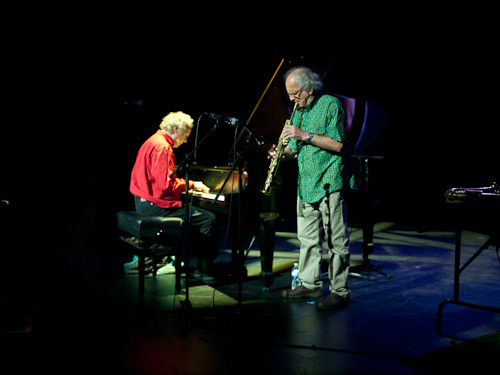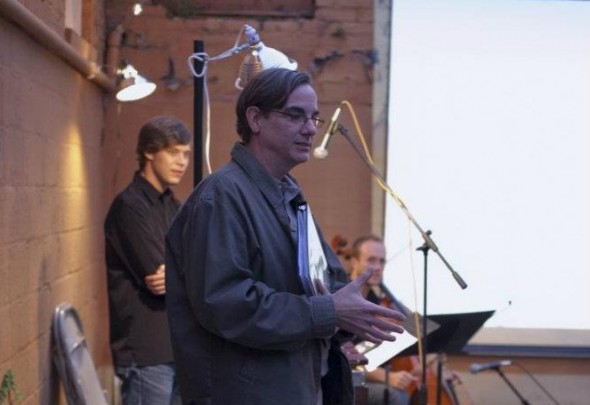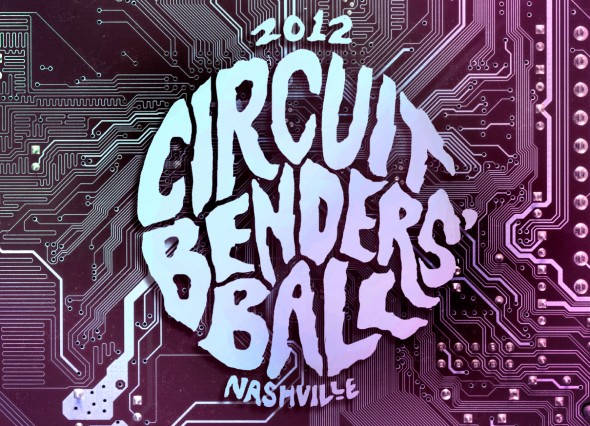
Funding for the Circuit Benders’ Ball has officially launched on our Kickstarter page! There are all sorts of great rewards for donating, including CBB t-shirts and posters and one-of-a-kind artwork and devices from CBB participants! Who will be the lucky person to scoop up Josh Gumiela’s one-of-a-kind sound sculpture? Many of the rewards are limited quantity, so hurry on over to Kickstarter.com and donate what you can! The success of the CBB depends entirely upon the support and the enthusiasm of our volunteers, participants, and audience. We can’t do this without you!
The Circuit Benders’ Ball workshops are now for sale on TheSkillery.com, a Brick Factory partner and “an online marketplace for affordable, offline classes and workshops led by experts in your community.” The three workshops are limited to 15 students each, so get your tickets before they sell out. Take one class and get a Circuit Benders’ Ball t-shirt for free! Take all three classes and get a free ticket to the music performances at 8pm!
Here are the workshop full descriptions:
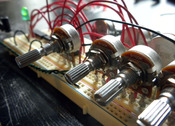 Chip to be Square: Build Your Own Synthesizer
Chip to be Square: Build Your Own Synthesizer
Buy tickets.
$55, Saturday September 29, 2012 10:00AM – 1:00PM
This workshop will teach you how to build your own square wave synthesizer. A synthesizer is an electronic musical instrument capable of producing a wide range of frequencies (notes) to make melodies. Square waves are one of the most commonly used waveforms in all synthesizers. They sound somewhat rough to our ears and might remind you of old 8-bit video game systems such as the Atari 2600 or Nintendo Entertainment System.
In this workshop you will:
– build a square wave synthesizer with sequencer you can take home
– learn the fundamentals of electronics from a beginner’s perspective
– acquire a collection of electronic components you can use after the workshop
– learn how to expand and experiment with the circuit you build
– be given a list of handy DIY resources for building future projects
The synthesizer you’ll build in this workshop (like this one) will play an adjustable melody using an integrated step sequencer. A step sequencer is an automated device that “steps through” each note one at a time in a repeating pattern. So instead of pressing keys as you would on a piano, you adjust each step of the sequencer to play a particular note in order to form your melody. You can adjust the rate (speed) at which your melody plays and change the individual notes in real time (via potentiometers) as the sequencer runs.
Your sequencer will consist of eight steps so your synth will thus play eight different notes. Your synth will include an audio output jack so you can plug it into a stereo system, amplifier, or computer to hear or record your performances. Amps will be provided at the workshop for testing and playing your synth.
In the process of building your synthesizer, you’ll learn the fundamentals of electronics, and specialized logic components such as integrated circuits (ICs) and digital waveform synthesis. You’ll also learn how you can modify your circuit to customize your synth and how you can incorporate the circuit into a larger musical system.
You’ll build your synthesizer on the provided breadboard, which means:
– you don’t have to solder a darn thing
– you can easily make modifications to your circuit to customize your synth
– you can reuse the breadboard and components to build other circuits
If you ever wanted to get into electronics but didn’t know where to begin, this workshop will give you all the materials and know-how you need to get started. You’ll be able to reuse your breadboard and components to build a variety of other projects in the future. You’ll also be provided with a list of handy DIY resources, such as useful tools & components, DIY-friendly vendors, and other cool circuits you can easily build and modify.
This event is part of the Circuit Benders’ Ball, a day-long celebration of hardware hacking, music, art, and the creative spirit. Register for one Circuit Benders’ Ball workshop and get a CBB t-shirt for free! (Limit 1 per student.) Register for all three Circuit Benders’ Ball workshops and get into the music showcase for free! (A $15 value.)
About the teacher: Josh Gumiela
Josh Gumiela is a sound designer, electronics tinkerer, and educator. He’s the proprietor of GumiElectronic.net, a DIY electronics blog providing free-as-in-freedom tutorials on circuit bending, modification, and design of electronic audio devices. He’s been teaching audio and interactive media classes since 2005. Josh is currently designing interactive sound sculptures and making peculiar sounds with his hand-made devices.
- Ideal For: Teens (13-18), Adults (18+), Males, Intellectuals, Professionals, Parents, Females, Techies and Nerds, Artists & Creative Souls
- Skills Taught: Electronics, circuitry, Create a Synthesizer
Class Requirements
This is a beginner’s level class. No prior electronics experience is necessary. At the end of the workshop you’ll take home a fully functional eight-step synthesizer to annoy your friends with. Come with the desire to learn and create. All materials are included.
Buy tickets.
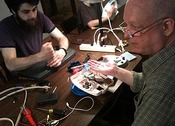 Introduction to Circuit Bending with Roth Mobot
Introduction to Circuit Bending with Roth Mobot
Buy tickets.
$45, Saturday September 29, 2012 2:00PM – 5:00PM
Circuit Bending (also called Hardware Hacking) is the creative recycling of common discarded technology, often children’s toys, by opening the device and soldering in new connections within the device’s pre-existing circuitry to create unique musical and video instruments.
In this workshop, you can take apart an old toy and make a brand new musical instrument! You’ll be able to identify and explore the basic components of a typical circuit board, the basics of soldering, install output jacks, switches, body contacts (and more!), and control a world of new sounds. Tools and components will be provided.
IMPORTANT: This workshop is BYOT (Bring Your Own Toy). Participants are required to bring one battery-powered device (with batteries!) to the class. It’s best to bring more than one toy too. Some toys just don’t bend. Sometimes a toy fries during the workshop. We don’t want anyone to be left out.
What’s a good toy to bend? Find out on Roth Mobot’s workshop page: http://www.rubbermonkey.org/rothmobot/workshops.htm
This event is part of the Circuit Benders’ Ball, a day-long celebration of hardware hacking, music, art, and the creative spirit. Register for one Circuit Benders’ Ball workshop and get a CBB t-shirt for free! (Limit 1 per student.) Register for all three Circuit Benders’ Ball workshops and get into the music showcase for free! (A $15 value.)
About the teachers: Roth Mobot
Roth Mobot is the Chicago-based Circuit Bent musical duo of Tommy Stephenson and Patrick McCarthy. Roth Mobot’s invention of “recursive jazz” controls the random juxtaposition of improvised dark ambient drones, languid melodies, randomly discovered rhythms, percussive accidents, the humorous language of toys, and common discarded electronic devices, in what they refer to as “strategic improvisation.”
Tommy Stephenson has been at the center of the Circuit Bending movement since the early 1990’s. His specialties include speed bending, mercury switches, capacitor cascades, and rehousing devices in trash-picked containers.
Patrick McCarthy has been conducting Circuit Bending workshops and courses in various Museums, Galleries, Schools, Symposium, Salons, and Corporate Seminars, since 1999. He is on staff at the Wanger Family Fab Lab at the Museum of Science and Industry in Chicago. He’s also on faculty at the Old Town School of Folk Music and teaches workshops at the school and teaches multiple residencies at various Chicago Public Schools via the OTSFM’s Education Outreach Program. He conducts regular teaching residencies at Chicago’s Experimental Sound Studio, and currently has an extended teaching residency at Near North Montessori School.
Class Details
- Ideal For: Artists & Creative Souls, Intellectuals, Females, Males, Techies and Nerds
- Skills Taught: circuity, circuit bending, hardware hacking
Class Requirements
No previous electronics experience is required. Participants are required to bring one or two battery-powered devices (with batteries!) to the class. All other class materials are included.
Buy tickets.
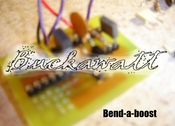 Build a Buckawatt “Bend-a-Boost” Modular Boost Kit
Build a Buckawatt “Bend-a-Boost” Modular Boost Kit
Buy tickets.
$45, Saturday September 29, 2012 5:30PM – 7:00PM
In this workshop, attendees will learn how to build and design a single stage amplifier using sockets. Attendees will practice beginner soldering skills, populating a circuit board with sockets, before experimenting with a number of different custom biasing configurations with no additional soldering. The lecture portion will include how the various different configurations work, while covering topics on the different modes and biasing of the transistors, as well as a brief intro on how the boosts work together in multiple stages to create overdrive and fuzz.
The Bend-a-Boost is a transistor-based boost kit that is easily configured on modular sockets. It is a single stage amplifier used to boost an audio signal, which works as an active volume control. This can be used to add color and character to other devices, and can be configured in a number of different ways to create signal clipping and oscillations. It has practical applications for circuit benders and stomp box lovers alike, and teaches building blocks of amplification, overdrive, and fuzz. The modular socket design allows builders to design multiple circuits and keep them semi-prematurely, to swap them out with no additional soldering.
This event is part of the Circuit Benders’ Ball, a day-long celebration of hardware hacking, music, art, and the creative spirit. Register for one Circuit Benders’ Ball workshop and get a CBB t-shirt for free! (Limit 1 per student.) Register for all three Circuit Benders’ Ball workshops and get into the music showcase for free! (A $15 value.)
About the teacher: Zach Adams
Zach Adams is a very active, genre hopping, experimental musician as a member of CMKT 4, The American Association of Robotic Philharmonics, Dumpling, and Gary Mullis’ Country Two Band, just to name a few. Zach, along with the members of CMKT 4, has performed and given nearly 100 workshops at over 50 hackersapces coast to coast, including The Brick Factory. In addition, he builds piezo mics and other bent devices for Creme DeMentia Labs, and in conjunction with Glass Hero Amplification, designs Buckawatt Electronic Kits. Zach is also an enthusiast for outsider education and unschooling.
Class Details
- Ideal For: Adults (18+), Artists & Creative Souls, College Students, Intellectuals, Females, Males, Techies and Nerds
- Skills Taught: Electronics, How to Build an Amplifier
Class Requirements
This workshop is Ideal for learning beginning soldering, and beginner to intermediate circuit theory. Come with the desire to learn and create. All materials included.
Buy tickets.


